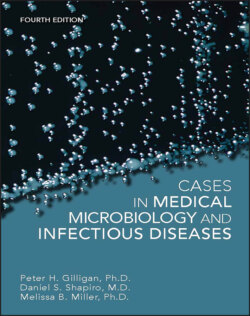Читать книгу Cases in Medical Microbiology and Infectious Diseases - Melissa B. Miller - Страница 32
SEROLOGY
ОглавлениеIt is not always possible to isolate a microorganism by culture, visualize it microscopically, or detect it by antigenic or molecular detection techniques. In those situations, an alternative approach is to determine if the patient has mounted an immune response against a specific agent as evidence that he or she has been infected with that agent. The immune response is generally measured by detecting antibodies in the serum of patients—thus the name serology.
Serology has both advantages and disadvantages. As advantages, (i) specimens for testing are readily available; (ii) antibodies are relatively stable molecules, so transport is not a major concern as it is with culture; and (iii) tests have been designed that can detect most known agents, such as HIV and HCV, which are difficult to detect by other means. Depending on the target antigen against which the immune response is measured, the test can show both high sensitivity and high specificity. Compared with other techniques, these tests are relatively inexpensive and easy to perform, in part because they have been automated. As a result, they can be used to screen large numbers of specimens for selected infectious agents. For example, this approach is used to screen blood products used for transfusions to ensure that the transfused patient does not receive blood contaminated with hepatitis B and C viruses, HIV, or T. pallidum, the agent of syphilis.
Serologic tests also have several disadvantages and should be interpreted with some caution. To have a positive test, the patient must have mounted an immune response. Serum obtained from an acutely ill patient may have been taken during the window period in an infection before the patient had time to mount an immune response. Therefore, to get the most accurate result, acute and convalescent specimens should be obtained. The convalescent specimen should show a significant increase (or, in some cases, decrease) from the antibody level of an acute specimen. This is usually a 4-fold change in the titer. Because the convalescent specimen should be obtained a minimum of 2 weeks after the acute specimen, serologic diagnosis is often retrospective. Because obtaining a convalescent specimen is often difficult logistically, the only value that may be available is that from the acute specimen. Patients may have relatively high antibody levels because of previous infection with the test organism and, as a result, may have a false-positive result. Antigenic cross-reactions between the test organism and other antigens may also lead to false-positive results. Some immunocompromised patients are unable to mount a response and may never have a positive serologic test.
Serologic tests can be done in combination using a screening test followed by a confirmatory test. This approach is used most commonly in the diagnosis of syphilis, HIV infection, and Lyme disease. The screening test should be highly sensitive so that all true-positive results will be detected. This test may not be highly specific, meaning that some results may be false positives. It should also be easily performed, so that large numbers of specimens can be tested fairly inexpensively. The confirmatory test needs to be highly specific so that the correct diagnosis can be applied to the patient who screens positive for the infectious agent. It tends to be much more expensive and technically complex than the screening test. Western blotting or an equivalent technique is used in the confirmatory tests for Lyme disease, HIV infection, and HCV infection. In this technique, a patient is considered to be positive for the agent only if the patient has antibodies to multiple specific antigens.
